Peter, Paul & Mary — ‘Early Morning Rain’ (studio version)
Peter, Paul & Mary — ‘Early Morning Rain’ (live video)
Darkened hall, packed auditorium, electric anticipation. The audience already begins to applaud as a silhouette jogs to the mike, guitar in hand. Entering the pin spot at center stage, in dark suit and tie, with trademark hipster Van Dyke beard, he leans in and says in his firm, passionate tenor, “Hi, I’m Peter, but I’m no saint.”
The crowd roars and laughs and applauds as the second figure, with the same guitar, suit and beard, moves through the dark into the spotlight– just like the first, only lanky and sweet, he twinkles in his resonant baritone, “Hi, I’m Paul, and I’m no saint.”
The laughter and applause swell as the third figure steps quickly through the dark, leans into the spotlight with her familiar, husky alto and the best hair of the entire decade, “Hi, I’m Mary , and I’m no virgin.”
And they launched into a powerful, upbeat, soul-stirring anthem of freedom and dignity and justice, based on a spiritual or a Woodie Guthrie ‘standard’ or a cosmic Dylan diatribe, the ink still wet, sung in the sweetest three-part harmony you’ve ever heard, supported only by the two nylon-string guitars and double bass in the background. Three voices, two guitars, a singular presence – Peter, Paul & Mary.
PP&M’s stature can’t be overstressed. After Dylan and The Beatles, they were one of the most important voices of the 1960s – artistically, commercially and historically. Somehow, they seemed to have slipped somewhat from the public eye and ear. Even Andrew Hickey in his exhaustive podcast “A History of Rock Music in 500 Songs” dismisses them as a Monkees-style group assembled by Albert Grossman for crass commercial reasons, completely missing the love their music evoked in that era and the centrality of their great contribution to the zeitgeist of the 1960s.
So let’s give them a most-deserved nod this week. Return with us now to those thrilling days of yesteryear, when A Song was A Song, when beautiful was beautiful, when the passion for justice put artists on the Top 40 charts. As Dylan put it so evocatively, “There was music in the cafes at night, and revolution in the air.”
In the late 1940s, ‘folk music’ had a brief flowering through voices such as The Weavers with Pete Seeger, Woodie Guthrie, and others. But they were radical leftists, and it was an Eisenhower/Hoover world. The Weavers were blacklisted, and Guthrie fell fatally ill. Folk music went underground throughout the 1950s; Greenwich Village the only vibrant enclave. The only faint commercial flicker came from voices such as Harry Belafonte. In the late 1950s, a spontaneous renaissance began. The radio started playing music by groups such as the Kingston Trio, the Limeliters, the Brothers Four, and the Highwaymen. Tiny clubs in the Village hosted aspiring young less commercial singers such as Eric Von Schmidt, Ramblin’ Jack Elliott, standup artists such as Mort Sahl and Lenny Bruce, and Dave Van Ronk, whose autobiography served as the basis for the Coen brothers’ fine depiction of the scene in “Inside Llewyn Davis“.
Twenty-year old Bob Zimmerman made a pilgrimage from Minnesota to Woody Guthrie’s deathbed in January 1961 and settled into the Village scene. David Hajdu’s fine book “Positively 4th Street” chronicles the early days of Dylan, the Baez sisters and the legendary writer/singer Richard Fariña. Joan Baez became the darling of the scene in 1961. Folk music became the soundtrack of the Kennedy era and the Civil Rights movement. Network TV offered a weekly show, “Hootenany”, that ran for a year and a half. Christopher Guest’s mockumentary film “A Mighty Wind” portrays a fictional reunion tribute to the ‘grand old man’ of the folk music movement; it’s one of the funniest movies I’ve ever seen, and I can’t recommend it highly enough.
But at the center of it all was Peter, Paul & Mary. In 1961, agent/opportunist supreme Albert Grossman identified the niche, and suggested to three denizens of the disheveled scene in the Village to try their hand at trio singing. Peter Yarrow (b. 1938), Mary Travers (1936-2009) and Noel Stookey (b. 1937) had nothing better to do with their days, and readily agreed. But these weren’t The Monkees. They spent seven months diligently rehearsing in Mary’s apartment.
Their first album (March 1962) was in the Billboard Top Ten for 10 months, including seven weeks at #1, and garnered them two Grammies. It contained ‘If I Had a Hammer’ and ‘Where Have All the Flowers Gone’ (both written by Seeger), which on the one hand perfectly embodied the optimistic, idealistic middle-class spirit of the Kennedy era (the Civil Rights movement), but were not yet perceived as provocatively anti-establishment (the Vietnam war still lay around the corner). Their second album contained ‘Puff (the Magic Dragon)’ (written by Yarrow) and Guthrie’s ‘This Land is Your Land’. It stayed on the charts for 99 weeks!
They sang pretty. Kids were listening to pop pap, the folks to Sinatra. But everyone loved Peter, Paul & Mary.
Their musicality is impressive today – the vocals, the accompaniment, the uniformly excellent repertoire. They were handsome and beautiful and intelligent and nice people, and funny and politically committed with just the right politics. But they also had dignity (they wore ties, they spoke with intelligent earnest) and gravitas (all three were committed activists on-stage and off- throughout their careers and lives). You didn’t just listen to their music, you paid attention. And you sang along, with gusto and sincerity.
Their niceness can’t be stressed too much. I had the opportunity to interview them twice in the latter 1960s. They were genuinely warm, refined, articulate humans, all three. I also had the opportunity to work with them at a political rally for Ohio senatorial candidate John Gilligan, where they came to lend their support together with Paul Newman and Eugene McCarthy. (Gilligan lost the election, but the day turned out pretty well for all of us: he eventually became governor, as did his daughter Kathleen Sebelius; Peter eventually married Gene’s daughter; and Paul would write ‘The Wedding Song (There is Love)’ for their wedding; I still brag to people about having met Paul Newman, about how short he was and how blue his eyes were, and how women gasped when they saw him up close.)
But the best was yet to come. In August, 1963, 250,000 people stood before the Lincoln Memorial in Washington, DC, at the ‘March on Washington for Jobs and Freedom’, one of the largest and most important political rallies in American history. Rev. Martin Luther King delivered his “I Have a Dream” speech (the whole speech, the famous part). Peter, Paul and Mary sang ‘If I Had a Hammer’ and a brand-new song by an unknown songwriter named Bob Dylan, ‘Blowing in the Wind’.
Their 3rd album, “In the Wind” (October, 1963, one month before the Kennedy assassination, four months before The Beatles first appeared on The Ed Sullivan Show), included Dylan’s ‘Don’t Think Twice (It’s Alright)’ and ‘Blowing in the Wind’. The single sold three hundred thousand copies in the first week of release. It also boasted a fascinating poem/liner notes by Dylan, describing those early days in the Village:
The rooster never crowed on MacDougal Street-/There was no dew on the grass an the sun never came shinin/over the mountain-/There was nothin t tell yuh it was morning cept the/pins and needles feelin in yer arms an legs from stayin/up all nite-/But all ‘f us find our way a knowing when it’s mornin-/An once yuh know the feelin it don’t change-/It can only grow-/For Peter’s grown/An Paul’s grown/An Mary’s grown/An the times’ve grown.
You young ‘uns may not know this, but these two recordings introduced Dylan to the world. It took years for him to get traction as a singer — no one (except weirdos like me) wanted to listen to him. “Yeah, he writes good songs, but I can’t take that voice.” Columbia Records resorted to the marketing slogan “Nobody sings Dylan like Dylan.” It didn’t help. Commercially, he was a back-bencher for years. What people wanted to hear was PP&M singing Dylan.
But then in the middle of the decade, the British invaded the US and the US invaded Vietnam, and the tone and temperament of the times were a-changing. The folk music movement ground to a halt. PP&M were the only survivors. They continued to record and perform, embraced both by the anti-war activists and their parents. The 1964 double LP “In Concert” (including ‘The Times They Are A-Changing’ and the hilarious Stookey standup ‘Paultalk’) was a major success. They toured at a frantic pace to full houses around the world.
Then from 1965–1967 came a series of four consensus albums (“A Song Will Rise”, “See What Tomorrow Brings”, “Album” and “Album 1700”), successfully balancing traditional materials, political ‘protest’ songs, and a remarkable series of discoveries of unknown or little-known singer-songwriters: the very first recording of a song written by Laura Nyro (‘And When I Die’, an inspiring reflection on life written when Laura was but 16!), Gordon Lightfoot (‘For Loving Me’ and our SoTW, ‘Early Morning Rain’), Ewan MacColl (‘The First Time Ever I Saw Your Face’), Tom Paxton (‘The Last Thing on My Mind’), Fred Neil (‘Another Side to This Life’), Richard Farina (‘Pack Up Your Sorrows’), and John Denver (the mega-hit ‘Leaving on a Jet Plane’). That is a quite a list of songs they coined as standards.
In addition, they began penning some memorable songs themselves (‘The Good Times We Had’, ‘The House Song’, ‘The Great Mandala’, ‘I Dig Rock and Roll Music’, ‘If I Had Wings’, ‘The Song is Love’, my much-beloved ‘Whatshername’).
By the late 1960s they had run out of steam. They continued to tour and perform and work for causes and appear at rallies and demonstrations, but their recordings lost their sparkle. In 1970, by mutual consent, they went on ‘sabbatical’. They never argued; they were just bushed. Over the ensuing years, they reunited for an annual Christmas concert and various causes and received all the awards you can think of. They remained on good terms throughout. Mary Travers died in 2009 of leukemia.
My personal legacy from Peter, Paul & Mary is great. I didn’t just own all their albums. I knew every note of Paul’s bass harmonies by heart. I could intuit his part on songs they had never sung. He was a teacher for me, not just for bass harmonies, but also as a paragon of gentleness and religious sincerity (he’s a practicing Christian). I admit that I don’t listen to their music too often nowadays; most of it I have committed to memory.
But one song has always been especially near and dear for me, their treatment of Gordon Lightfoot’s ‘Early Morning Rain’. It’s one of those very few songs that without fail touch me in the deepest place. I can be pitching for the NY Yankees in the 7th game of the World Series–PP&M’s ‘Early Morning Rain’ goes through my mind, and I’m transported to a very distant, specific, place: 4 AM, soaked and cold, aching from a lack of sleep and a broken heart, looking up at a jet plane flying overhead.
Gordon Lightfoot (b. 1938) was a Canadian paleface singer-songwriter without a recording contract when PP&M recorded his two most famous songs (here are his originals of ‘For Loving Me’ and ‘Early Morning Rain’). They weren’t the only ones to record Gordon in those days, or even the first, but they made the iconic versions. ‘Early Morning Rain’ is a gift PP&M have been sharing with me for 45 years now, and I’m so glad to have the opportunity to share it onwards.
In the early morning rain, with a dollar in my hand
With an aching in my heart and my pockets full of sand
I’m a long way from home, and I miss my loved one so
In the early morning rain with no place to go
Out on runway number nine, big 707 set to go
But I’m stuck here on the ground where the cold winds blow
Well the liquor tasted good and the women were all fast
There she goes my friend, o she’s rolling now at last
Here the mighty engines roar, see the silver bird on high
She’s away and westward bound, high above the clouds she’ll fly
Where the early rain don’t fall and the sun always shines
She’ll be flying o’er my home in about three hours time
This old airport’s got me down, it’s no earthly use to me
Cause I’m stuck here on the ground, cold and drunk as I might be
You can’t jump a jet plane like you can a freight train
So I’d best be on my way in the early morning rain
If you enjoyed this post, you may also like:
SoTW 13: Tim Hardin, ‘Black Sheep Boy’ SoTW 16: Bob Dylan, ‘Percy’s Song’ SoTW 141: Joni Mitchell, ‘I Don’t Know Where I Stand’
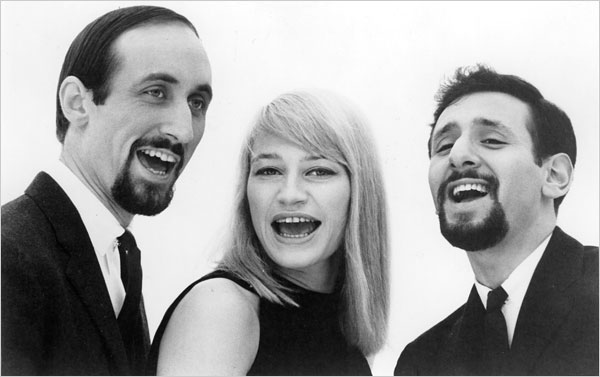
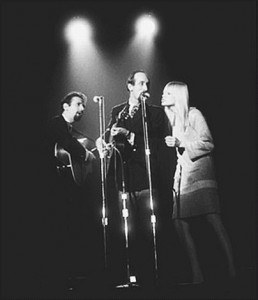
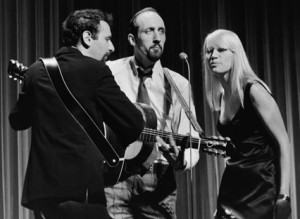
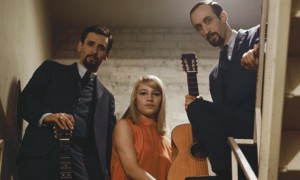
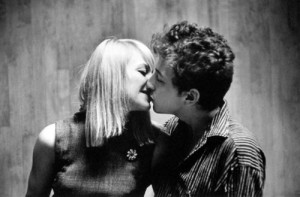
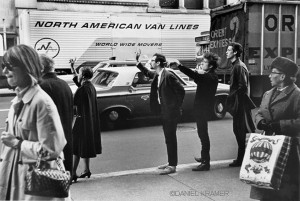

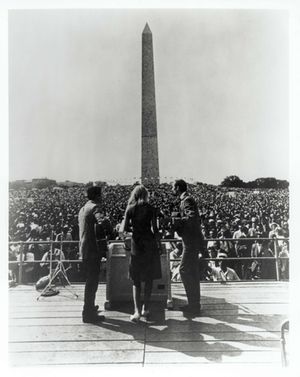
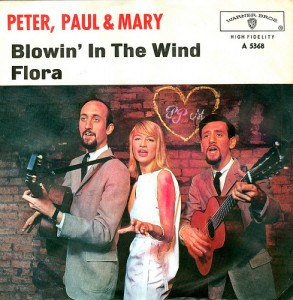
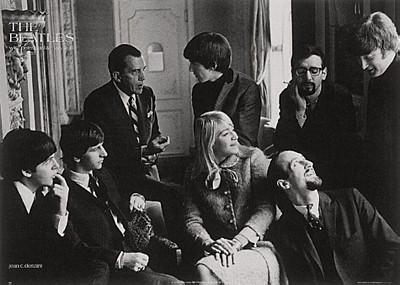
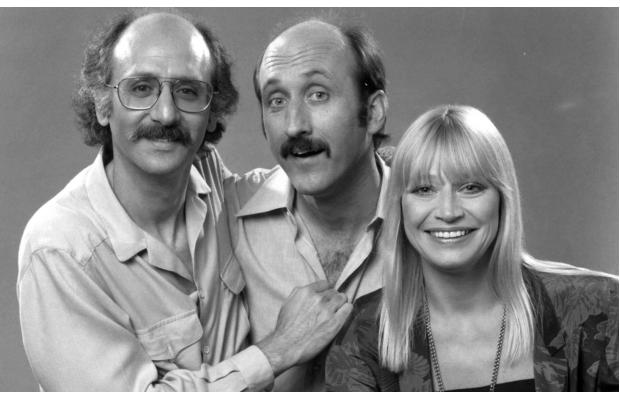
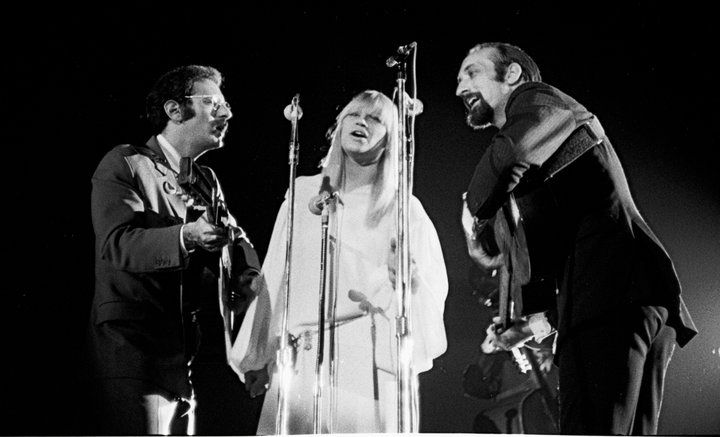


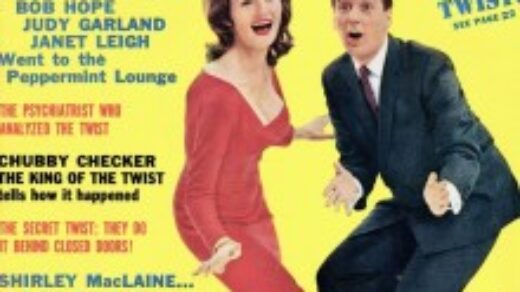
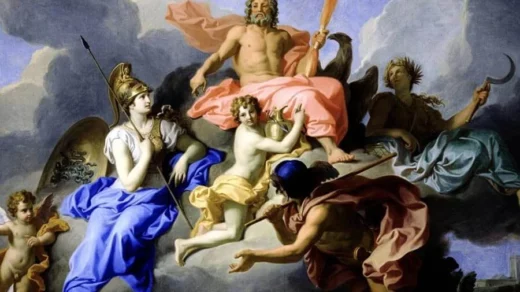
I grew up on them. I remember staying with my grandmother while my parents went to see them in the ’60s in Wheeling, West Virginia.
Thanks for the lovely stroll down memory lane.
Oh happy memories! I think they, together with Joan Baez, gave me my interest in listening to music….and The Everly Bros and Paul Anka and Rickie Nelson and……………………..Frankie Natra
Hi Jeff –
Glad to see you back in the saddle with SOTW. Loved this post almost as much as I loved Peter, Paul & Mary. (my favorite song is “Bob Dylan’s Dream”)
“I wish, I wish, I wish in vain
That we could sit simply in that room once again.
Ten thousand dollars at the drop of a hat,
I’d give it all gladly, if our lives could be like that”.
Oy – 1971 is calling me..what a great (and awful) time that was…
Sue
“I wish, I wish, I wish in vain
That we could sit simply in that room, once again.
Ten thousand dollars at the drop of a hat,
I’d give it all gladly, if our lives could be like that”
“Bob Dylan’s Dream” Album 1700
Gosh, high school returns, as if by magic. Thanks Jeff!
Sue
@Sue; a propos “Bob Dylan’s Dream”–I agree, they do a really great job on the song. It’s a song that touches me very deeply, in this place:
https://jmeshel.com//046-james-taylor-never-die-young/
from Rod Pennington: “I don’t know if you remember this or not but when they set the stage up for PPM in the spring of 1969 it wasn’t centered under the sound system. Peter blew his stack and volunteers from the audience actually got up and helped move the stage before they started. You can see them moving it in the block of photos you linked to in your blog.”
I’m a 17 year old, and I don’t even know why yet I just love folk Music. Thank you so much for writting this, it’s really nice to see other people love their work. It’s great for me to know more and more about them, they are definitely one of my favorites, with John Denver and DYlan, and many others. Thanks again, it’s great for one to know alll this history and be more convinced that they all were what one should be.
I was a Folkie then, I’m still a Folkie now. Thanks for this post!
Wonderful. Thanks so much, Jeff 🙂
one of yr best columns ever…what a trip! lying on the grass high above sultans pool, jerusalem, early 70s, saw them in concert.
thanks for this one.
I still love the way you write. All the way back to the “Bulldog Barks”! I think I saw them twice at Music Hall in Cincinnati and also their last concert in Louisville at The Palace. “Bob Dylan’s Dream” still speaks to me. But in your intro you forgot to mention the stand up base player that travelled with them. Paul also had at least one solo album. Great job, as always.
Who did the vocal arrangements for PPM? “Early Morning Rain” is so finely crafted!
As far as I know, they did them themselves. Milt Okun was their producer, Bill Lee (father of Spike) their bassist.
Their vocal arrangements really were sterling. And they were tremendously influential in their time.
They were some years ahead of me but I will always remember my older cousin forming a PP&M style group in her living room made up of her high school friends. They sang If I Had a Hammer and Blowin in the Wind. I thought Mary’s voice was the ultimate in womanliness and love her on Leavin on a Jet Plane. As one of those Beatle Maniacs, I always viewed PP& M as elder statespeople.
Your wonderful blog inspired me to listen to PP&M again, after many years!
I loved them and still listen to their albums. I believe Mary was from Louisville.
Beautitful blog! I received their first album as a gift in 1962, and since then have accumulated at leat 15 more.On vinyl, tape (one album which includes the Unicorn Song was never put out on vinyl or disk) and CDs. Saw them twice in the States, including a beautiful concert in Carnegie Hall. A high point of my life was seeing them in Jerusalem when they performed in Sultan’s Pool.Got Peter’s autograph in the lobby of the Inbal (thenLaromme) Hote. And seeing Paul on his own in Tel Aviv years later.”Jet Plane” was my ring tone for many years. Part of my life for 60 years.